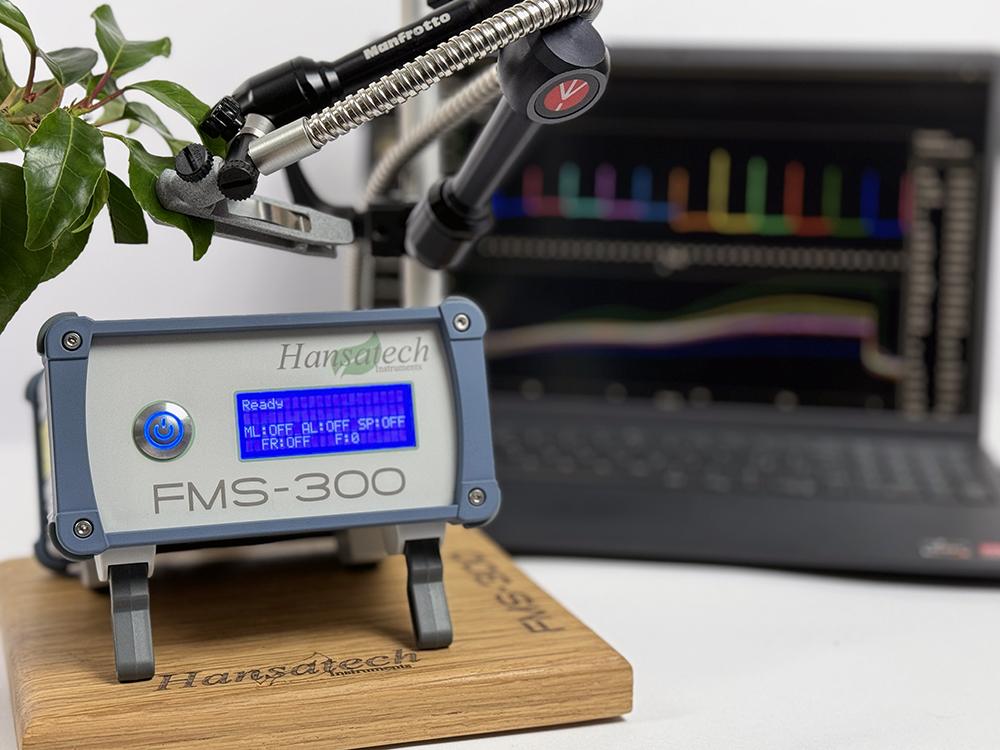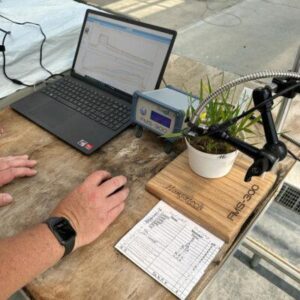Pulse Amplitude Modulated (PAM) Chlorophyll Fluorometer

FMS-300 is a state-of-the-art, Pulse Amplitude Modulated (PAM) chlorophyll fluorometer combining the usability of a teaching system with the power and functionality to provide high-level research-grade data. A wide range of accessory components allow experiments to be conducted on many different sample types.
Newcomers to the technique are quickly able to acquire and analyse data, making FMS-300 an ideal system for teaching chlorophyll fluorescence. Yet it is also a highly capable research instrument offering flexibility, functionality, and data acquisition of exceptional quality. Extensive features and capabilities allow the system to be used to demonstrate complex concepts, conduct experiments, collect data, analyse results, and facilitate collaborative learning or research projects.

Primarily a laboratory-based system, FMS-300 can extend to greenhouse and field applications when coupled with an appropriate portable power source.
The enviable signal quality is achieved via ultra-short measuring pulses with a standard frequency of 10 Hz (up to 100 kHz during fast fluorescence capture). At just 400 ns per pulse, FMS-300 can emit high-intensity measuring pulses with user-defined average intensities up to 0.1 μmol m-2 s-1. This combination of high-intensity and ultra-short pulse width produces a strong fluorescence signal with no requirement for signal damping or data averaging. The user is presented with 100% raw instrument data.
FMS-300 is a state-of-the-art, Pulse Amplitude Modulated (PAM) chlorophyll fluorometer combining the usability of a teaching system with the power and functionality to provide high-level research-grade data. Key features of the FMS-300 are as follows:
Versatile functionality:
Suitable for both teaching and research applications. FMS-300 can demonstrate complex concepts, conduct experiments, collect data, analyse results, and facilitate collaborative learning or research projects.
Fast & slow fluorescence data:
Presents fast and slow fluorescence data with equal emphasis. Fast fluorescence kinetics are captured during every saturating pulse for both dark- and light-adapted sample states, presenting opportunities for novel research.
Comprehensive parameter display:
Parameter sets relevant to the selected routine are calculated for each saturating pulse. For dark-adapted samples, OJIP parameters in addition to parameters such as Fv/Fm are calculated. Light-adapted parameters including ETR, ΦPSII, Lake and Puddle models for non-photochemical quenching, and both a calculated Fo’ and Fo’ measured under far-red light are calculated where appropriate.
Developed for high performance:
A measuring pulse width of 400 ns from a dedicated LED allows greater intensities to be implemented yielding a strong, low-noise signal. Measuring pulse intensity can be defined between *0.001 – 0.1 µmol m-2 s-1. Actinic and saturating pulse intensities of up to 3,000 and **20,000 µmol m-2 s-1 respectively can be delivered at the sample surface.
Streamlined data capture:
FluoroControl software provides 6 pre-set experimental routines, which can be further configured, if required. This enables rapid learning and efficient, hassle-free data acquisition.
Intuitive software with simplified control set:
Developed from the ground up with simplicity in mind. A user-friendly interface with minimal learning curve allows easy navigation of the different functions and options.
Data visualisation & analysis:
The measuring LED performance means that 100% raw data is presented with no requirement to damp or average. Robust data visualisation, analysis and export tools allow users to interpret and present findings effectively. Valuable for both teaching complex concepts and conducting in-depth analysis in research applications.
Measuring light & actinic/saturating LED colours:
4 variants with different pairings of LED colour. Supplied with either blue/blue (455 nm), red/red (624 nm), blue/white or red/white measuring/actinic and saturating LEDs. All variants contain a far-red LED (730 nm) for determination of Fo’ during the quenching analysis routine.